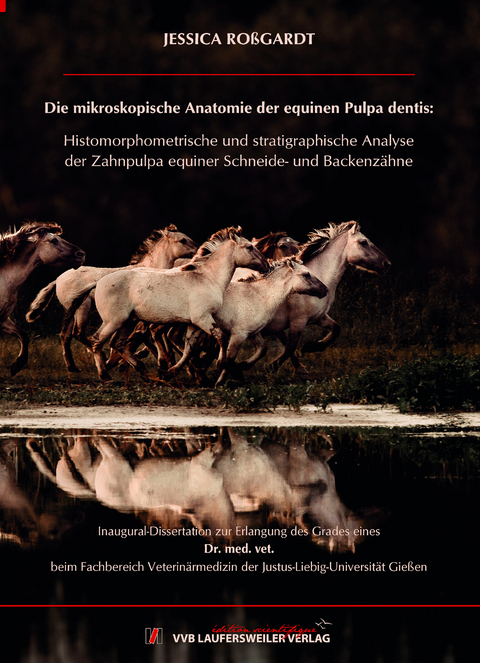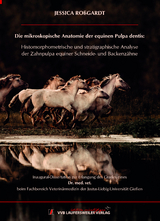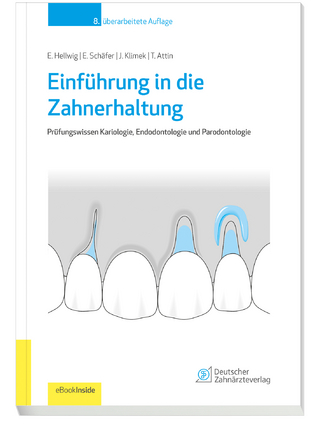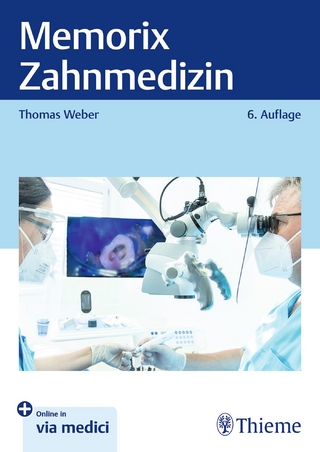Die mikroskopische Anatomie der equinen Pulpa dentis:
Histomorphometrische und stratigraphische Analyse der Zahnpulpa equiner Schneide- und Backenzähne
Seiten
2023
VVB Laufersweiler Verlag
978-3-8359-7127-1 (ISBN)
VVB Laufersweiler Verlag
978-3-8359-7127-1 (ISBN)
- Keine Verlagsinformationen verfügbar
- Artikel merken
Das sich schnell entwickelnde Gebiet der Pferdezahnheilkunde erfordert immer detailliertere Kenntnisse über die pferdespezifische Zahnmorphologie, um immer komplexere Behandlungs¬techniken, z.B. endodontische Therapien, anzuwenden. Die offensichtlichen, grundlegenden Unterschiede zwischen den hypsodonten Zähnen des Pferdes und den brachydonten Zähnen des Menschen und der Kleintiere (Hund, Katze) schließen eine Übertragung der Kenntnisse, welche an brachydonten Zähnen erarbeitet wurden, auf die Spezies Pferd aus. Dementsprechend bedarf es eigener Studien an equinem Probenmaterial, um morphologische Grundlagen für die Entwicklung pferdespezifischer Therapien zu generieren.
Der dauerhafte Abrieb am hypsodonten Pferdezahn erfordert eine – bis ins hohe Alter der Tiere – andauernde Produktion von Dentinmassen, um die weit okklusal gelegenen Bereiche des vitalen Pulpagewebes abzudecken und zu schützen. Allerdings deutet die für den brachydonten Zahn typische stratigraphische Anordnung verschiedener Zonen in der Pulpaperipherie auf einen wenig aktiven und maturen Zahnstatus hin. Es stellt sich daher die Frage, ob die funktionalen Unterschiede einer lebenslang aktiven Dentinproduktion im hypsodonten Zahn gleichfalls morphologische Veränderungen im endodontischen System equiner Zähne be¬dingen. Folglich war das Ziel dieser Studie eine erstmalig detaillierte, anatomische Beschreibung und Analyse der equinen Pulpa dentis anhand histologischer und immunhisto¬chemischer Untersuchungsmethoden durchzuführen. Hierbei wurde nicht nur auf altersbedingte histomorphometrische Veränderungen geachtet (Länge, Breite und Fläche im Querschnitt), sondern auch histomorphologische Charakteristika und deren Veränderungen in Abhängigkeit des Alters analysiert (Odontoblasten, Mineralisierung des Prädentins, Blutgefäße, Nervenfasern und zelluläre Bestandteile).
Insgesamt wurden für diese Studie 10 mandibuläre Schneidezähne (davon vier Milchschneide¬zähne) und 10 maxilläre, prämolare Backenzähne (davon vier Milchbackenzähne) genutzt. Postmortem wurde eine klinische Untersuchung der Zähne vorgenommen. Für die weitere histologische und immunhistochemische Bearbeitung wurden nur klinisch gesunde Zähne genutzt. Die Proben wurden in 10%iger, gepufferter Formalinlösung fixiert. Mit einer diamantblatt-beschichteten Mikrobandsäge wurden drei horizontale Sägeschnitte auf verschie¬denen Ebenen durchgeführt (subokklusal, zentral und apikal), die daraufhin über einen Zeitraum von acht Wochen in EDTA-Lösung entkalkt wurden. Im Anschluss wurden nach der Einbettung in Paraffinwachs histologische Schnittpräparate angefertigt und gemäß einem Routineprotokoll in Toluidinblau angefärbt. Eine ausgewählte Teilmenge wurde mittels immunhistochemischer Färbetechniken auf Blutgefäße (von-Willebrand Faktor VIII für Endothelien) und neuronale Strukturen (Neurofilamentprotein für Nervenfasern) untersucht.
Im Vergleich zu adulten Pferden wurde bei Fohlen (AG 1) sowohl in Milchschneide- als auch in Milchbackenzähnen eine deutlich ausgedehntere Zahnpulpa im Horizontalschnitt nachge¬wiesen. In Milchschneidezähnen nahm die Pulpa dentis im subokklusalen Bereich eine nahezu ovale Form ein und verjüngte sich in apikale Richtung. In permanenten Schneidezähnen (AG 2 und AG 3) kam es zu einem röhrenförmigen Verlauf von subokklusal nach apikal. Dieser röhrenförmige Verlauf konnte auch bei Backenzähnen alter Pferde (AG 3) nachvollzogen werden. Anders als bei Schneidezähnen kam es bei Milchbackenzähnen und permanenten Backenzähnen adulter Pferde (AG 1 und AG 2) zu einer kegelförmigen Erweiterung der Zahnpulpa in apikale Richtung. Während sich die Morphometrie der equinen Pulpa dentis mit zunehmendem Alter veränderte, so blieben die Breite der Odontoblastenschicht (20–40 µm) und die Breite des Prädentins (7–14 µm) in Schneide- wie auch in Backenzähnen nahezu unverändert. Auch die histologische Form der Odontoblasten veränderte sich bis ins hohe Zahnalter nicht. Im Bereich des Prädentins wiesen zwei Drittel der untersuchten Zähne eine gemischte lineare wie auch globuläre Mineralisationsfront auf.
Anhand der immunhistochemisch angefärbten Schnitte wurde eine Analyse der Blutgefäß- und Nervenfaserausstattung im Pulpagewebe vorgenommen. Hierbei fiel auf, dass es zu einer Zunahme der Blutgefäßdichte sowohl in Schneide- als auch Backenzähnen kam. Des Weiteren wurde die höchste Dichte von Blutgefäßen mit einem Durchmesser < 10 µm in der Peripherie der Zahnpulpa direkt angrenzend an die Odontoblastenschicht nachgewiesen, wo sie ein nutritives Kapillargeflecht ausbildeten. Blutgefäße mit einem Durchmesser von bis zu 50 µm oder größer wurden stets in den zentral gelegenen Bereichen der equinen Pulpa dentis beobachtet.
Die geringste Nervenfaserdichte wurde sowohl in Milchschneide- als auch Milchbackenzähnen festgestellt, wobei es hierbei zu einem gleichmäßigen Verteilungsmuster kam. Im Gegensatz dazu wurde eine Akkumulation der Nervenfaserdichte bei permanenten Zähnen adulter und älterer Pferde (AG 2 und AG 3) in der Peripherie beobachtet. Darüber hinaus wurden auf subokklusaler Schnittebene zahlreiche Verzweigungen der Nervenfasern angrenzend an die Odontoblastenschicht erfasst, was auf das Vorhandensein eines subodontoblastischen Nerven¬plexus schließen lässt. Generell zeigte sich eine Abnahme der Nervenfaserdichte von subokklusal nach apikal sowohl in Schneide- als auch Backenzähnen.
Während die Dichte der fibroblastischen Zellen in Schneidezähnen in allen Altersgruppen (AG 1–AG 3) nahezu konstant blieb, wurde in Backenzähnen eine signifikante Zunahme der Zelldichte festgestellt. In der Peripherie wurde, entsprechend den Beobachtungen bei Blutgefäßen und Nervenfasern, die höchste Zelldichte nachgewiesen. Eine zonale Gliederung, wie sie für die brachydonten Zähne des Menschen beschrieben ist (zellfreie Zone, zellreiche Zone) und auf einen maturen, weniger aktiven Zahnstatus hindeutet, wurde hingegen nicht beobachtet.
Zusammenfassend wird deutlich gezeigt, dass sich die equine Pulpa dentis maßgeblich von der brachydonten Pulpa dentis sowohl in ihren histomorphometrischen als auch histomorphologischen Eigenschaften unterscheidet. Die vorgefundenen histologischen Charak¬teristika weisen auf einen altersunabhängigen, hohen Aktivitätsstatus der equinen Pulpa dentis hin, welcher eine stets andauernde Produktionsrate an Sekundärdentin gewährleistet. Diese besondere Eigenschaft des equinen Pulpagewebes wird als evolutionäre Anpassung an den dauerhaften okklusalen Zahnabrieb interpretiert. So kann eine stets drohende, abriebsbedingte okklusale Exposition des empfindlichen Pulpagewebes vermieden und gleichzeitig schnell und effizient auf pathogene Stimuli reagiert werden. Weiterführende Studien werden zeigen, ob und in welcher Weise die große reaktive Potenz der equinen Pulpa auch therapeutisch genutzt werden kann. The microscopic anatomy of the equine dental pulp: Histomorphometric and stratigraphic analysis of the dental pulp in equine incisors and molars.
The developing field of equine dentistry requires detailed knowledge of equine-specific tooth morphology and anatomy in order to apply complex treatment techniques such as endodontic therapies. The fundamental differences between hypsodont teeth of horses and brachydont teeth of humans and small animals (dogs, cats) preclude the transfer of knowledge gained on brachydont teeth. Accordingly, studies on equine specimens are required to generate morphological basics for the development of equine-specific therapies.
The permanent dental wear of the equine tooth requires a continuous production of dentin, even in older horses, to prevent occlusal exposure of the vital pulp tissue. However, the pulp of brachydont teeth of humans is considered to develop a less active and mature status with age which is indicated – on a morphological level – by a stratigraphic arrangement containing different zones in the pulp periphery.
Therefore, the question arises whether the functional differences of a lifelong dentin production in the hypsodont tooth reflects morphological differences in the endodontic system of equine teeth. The aim of this study was to perform a detailed anatomical description and analysis of the equine dental pulp using histological and immunohistochemical examination methods. Special attention was paid not only to age-related histomorphometric changes (length, width and area in cross-section), but also histomorphological characteristics and their changes in relation to age were analyzed (odontoblasts, mineralization of predentin, blood vessels, nerve fibers and cellular components).
In total, 10 incisors (including 4 deciduous incisors) from the lower jaw and 10 cheek teeth (including 4 deciduous cheek teeth) from the upper jaw were used for this study. Postmortem, a macroscopic examination of all teeth was performed, and only clinically healthy teeth were used for further histological and immunohistochemical examinations. All specimens were stored in 10% buffered formalin. Subsequently, horizontal sections were taken from three defined levels (subocclusal, central, apical) using a diamond-coated, water-cooled micro-band saw. After 8 weeks of decalcification in EDTA solution, the specimens were embedded in paraffin wax and histological sections were prepared and stained in toluidine blue. A subset was examined by immunohistochemical staining techniques for blood vessels (von-Willebrand factor VIII for the detection of blood vascular endothelial cells) and neuronal structures (neurofilament protein for the detection of nerve fibers).
In contrast to adult horses, the horizontal expansion of the dental pulp (length, width and total area) in deciduous incisors and cheek teeth of foals (AG 1) was significantly enlarged. In deciduous incisors a nearly oval shape in the subocclusal area was observed, tapering in apical direction. In permanent incisors of adult and older horses (AG 2 and AG 3) the horizontal expansion of the pulp remained nearly constant, forming a straw-like shape. The same phenomenon was found in cheek teeth of older horses (AG 3). In contrast to the latter finding, the horizontal expansion of cheek teeth of horses of AG 1 and AG 2 was enlarged in apical direction, forming a cone-like shape.
Although the expansion of the equine dental pulp changed with age, the width of the odontoblastic layer (20–40µm) and the width of the predentin (7–14µm) remained constant in incisors as well as in cheek teeth. Furthermore, no age-related changes of the shape of the odontoblasts were observed. Additionally, two thirds of the examined teeth showed a linear as well as a globular mineralisation front, displaying a wave-like and ongoing mineralisation.
Immunohistochemically stained sections were used to evaluate the blood vessel and nerve fiber density. In general, the density of blood vessels showed an increasing trend with age in incisors as well as in cheek teeth. The highest density of blood vessels with a diamter < 10 µm was detected in the periphery of the equine dental pulp, adjacent to the odontoblastic layer forming a nutritive capillary network. Blood vessels with a diameter up to 50 µm or even larger were not obtained in the periphery but in the central area of the dental pulp.
The lowest density of nerve fibers was recorded in deciduous incisors as well as in deciduous cheek teeth of foals (AG 1), displaying a more or less uniform distribution. In contrast, an accumulation of nerve fibers was observed in permanent incisors and cheek teeth of adult and older horses (AG 2 and AG 3) in the periphery of the dental pulp, where heavily branched nerve fibers were obtained within the subocclusal area, suggesting the presence of a subodontoblastic nerve fiber plexus. Additionally, an overall decrease of nerve fiber density in incisors and cheek teeth was recorded from subocclusal to apical.
In incisors, the density of fibroblastic cells remained almost constant in all age groups, whereas cheek teeth showed a significant decrease. The highest density of fibroblastic cells was detected in the periphery of the dental pulp, similar to the distribution pattern of blood vessels and nerve fibers. A stratigraphic arrangement as described for brachydont teeth of humans (cell-free and a cell-rich zone in the periphery of the dental pulp), indicating a mature and less active status was not observed within the equine dental pulp.
The presented results illustrate massive histomorphometrical as well as histomorphological differences between the equine dental pulp and the dental pulp of brachydont teeth.
The histological characteristics found in the equine dental pulp indicate an age-independent and highly active status of the dental pulp, maintaining a continuous production of secondary dentin. This specific characteristic of the equine pulpal tissue is considered as an evolutionary adaptation to the lifelong occlusal wear of the tooth. Thus, under physiological conditions occlusal exposure of the sensitive pulpal tissue due to abrasion is avoided; under pathological conditions the pulpal tissue is able to react quickly and efficiently to pathogenic stimuli. Further investigations are needed to evaluate the potential use of the high productivity of the equine dental pulp for the development of equine specific therapeutically strategies.
Der dauerhafte Abrieb am hypsodonten Pferdezahn erfordert eine – bis ins hohe Alter der Tiere – andauernde Produktion von Dentinmassen, um die weit okklusal gelegenen Bereiche des vitalen Pulpagewebes abzudecken und zu schützen. Allerdings deutet die für den brachydonten Zahn typische stratigraphische Anordnung verschiedener Zonen in der Pulpaperipherie auf einen wenig aktiven und maturen Zahnstatus hin. Es stellt sich daher die Frage, ob die funktionalen Unterschiede einer lebenslang aktiven Dentinproduktion im hypsodonten Zahn gleichfalls morphologische Veränderungen im endodontischen System equiner Zähne be¬dingen. Folglich war das Ziel dieser Studie eine erstmalig detaillierte, anatomische Beschreibung und Analyse der equinen Pulpa dentis anhand histologischer und immunhisto¬chemischer Untersuchungsmethoden durchzuführen. Hierbei wurde nicht nur auf altersbedingte histomorphometrische Veränderungen geachtet (Länge, Breite und Fläche im Querschnitt), sondern auch histomorphologische Charakteristika und deren Veränderungen in Abhängigkeit des Alters analysiert (Odontoblasten, Mineralisierung des Prädentins, Blutgefäße, Nervenfasern und zelluläre Bestandteile).
Insgesamt wurden für diese Studie 10 mandibuläre Schneidezähne (davon vier Milchschneide¬zähne) und 10 maxilläre, prämolare Backenzähne (davon vier Milchbackenzähne) genutzt. Postmortem wurde eine klinische Untersuchung der Zähne vorgenommen. Für die weitere histologische und immunhistochemische Bearbeitung wurden nur klinisch gesunde Zähne genutzt. Die Proben wurden in 10%iger, gepufferter Formalinlösung fixiert. Mit einer diamantblatt-beschichteten Mikrobandsäge wurden drei horizontale Sägeschnitte auf verschie¬denen Ebenen durchgeführt (subokklusal, zentral und apikal), die daraufhin über einen Zeitraum von acht Wochen in EDTA-Lösung entkalkt wurden. Im Anschluss wurden nach der Einbettung in Paraffinwachs histologische Schnittpräparate angefertigt und gemäß einem Routineprotokoll in Toluidinblau angefärbt. Eine ausgewählte Teilmenge wurde mittels immunhistochemischer Färbetechniken auf Blutgefäße (von-Willebrand Faktor VIII für Endothelien) und neuronale Strukturen (Neurofilamentprotein für Nervenfasern) untersucht.
Im Vergleich zu adulten Pferden wurde bei Fohlen (AG 1) sowohl in Milchschneide- als auch in Milchbackenzähnen eine deutlich ausgedehntere Zahnpulpa im Horizontalschnitt nachge¬wiesen. In Milchschneidezähnen nahm die Pulpa dentis im subokklusalen Bereich eine nahezu ovale Form ein und verjüngte sich in apikale Richtung. In permanenten Schneidezähnen (AG 2 und AG 3) kam es zu einem röhrenförmigen Verlauf von subokklusal nach apikal. Dieser röhrenförmige Verlauf konnte auch bei Backenzähnen alter Pferde (AG 3) nachvollzogen werden. Anders als bei Schneidezähnen kam es bei Milchbackenzähnen und permanenten Backenzähnen adulter Pferde (AG 1 und AG 2) zu einer kegelförmigen Erweiterung der Zahnpulpa in apikale Richtung. Während sich die Morphometrie der equinen Pulpa dentis mit zunehmendem Alter veränderte, so blieben die Breite der Odontoblastenschicht (20–40 µm) und die Breite des Prädentins (7–14 µm) in Schneide- wie auch in Backenzähnen nahezu unverändert. Auch die histologische Form der Odontoblasten veränderte sich bis ins hohe Zahnalter nicht. Im Bereich des Prädentins wiesen zwei Drittel der untersuchten Zähne eine gemischte lineare wie auch globuläre Mineralisationsfront auf.
Anhand der immunhistochemisch angefärbten Schnitte wurde eine Analyse der Blutgefäß- und Nervenfaserausstattung im Pulpagewebe vorgenommen. Hierbei fiel auf, dass es zu einer Zunahme der Blutgefäßdichte sowohl in Schneide- als auch Backenzähnen kam. Des Weiteren wurde die höchste Dichte von Blutgefäßen mit einem Durchmesser < 10 µm in der Peripherie der Zahnpulpa direkt angrenzend an die Odontoblastenschicht nachgewiesen, wo sie ein nutritives Kapillargeflecht ausbildeten. Blutgefäße mit einem Durchmesser von bis zu 50 µm oder größer wurden stets in den zentral gelegenen Bereichen der equinen Pulpa dentis beobachtet.
Die geringste Nervenfaserdichte wurde sowohl in Milchschneide- als auch Milchbackenzähnen festgestellt, wobei es hierbei zu einem gleichmäßigen Verteilungsmuster kam. Im Gegensatz dazu wurde eine Akkumulation der Nervenfaserdichte bei permanenten Zähnen adulter und älterer Pferde (AG 2 und AG 3) in der Peripherie beobachtet. Darüber hinaus wurden auf subokklusaler Schnittebene zahlreiche Verzweigungen der Nervenfasern angrenzend an die Odontoblastenschicht erfasst, was auf das Vorhandensein eines subodontoblastischen Nerven¬plexus schließen lässt. Generell zeigte sich eine Abnahme der Nervenfaserdichte von subokklusal nach apikal sowohl in Schneide- als auch Backenzähnen.
Während die Dichte der fibroblastischen Zellen in Schneidezähnen in allen Altersgruppen (AG 1–AG 3) nahezu konstant blieb, wurde in Backenzähnen eine signifikante Zunahme der Zelldichte festgestellt. In der Peripherie wurde, entsprechend den Beobachtungen bei Blutgefäßen und Nervenfasern, die höchste Zelldichte nachgewiesen. Eine zonale Gliederung, wie sie für die brachydonten Zähne des Menschen beschrieben ist (zellfreie Zone, zellreiche Zone) und auf einen maturen, weniger aktiven Zahnstatus hindeutet, wurde hingegen nicht beobachtet.
Zusammenfassend wird deutlich gezeigt, dass sich die equine Pulpa dentis maßgeblich von der brachydonten Pulpa dentis sowohl in ihren histomorphometrischen als auch histomorphologischen Eigenschaften unterscheidet. Die vorgefundenen histologischen Charak¬teristika weisen auf einen altersunabhängigen, hohen Aktivitätsstatus der equinen Pulpa dentis hin, welcher eine stets andauernde Produktionsrate an Sekundärdentin gewährleistet. Diese besondere Eigenschaft des equinen Pulpagewebes wird als evolutionäre Anpassung an den dauerhaften okklusalen Zahnabrieb interpretiert. So kann eine stets drohende, abriebsbedingte okklusale Exposition des empfindlichen Pulpagewebes vermieden und gleichzeitig schnell und effizient auf pathogene Stimuli reagiert werden. Weiterführende Studien werden zeigen, ob und in welcher Weise die große reaktive Potenz der equinen Pulpa auch therapeutisch genutzt werden kann. The microscopic anatomy of the equine dental pulp: Histomorphometric and stratigraphic analysis of the dental pulp in equine incisors and molars.
The developing field of equine dentistry requires detailed knowledge of equine-specific tooth morphology and anatomy in order to apply complex treatment techniques such as endodontic therapies. The fundamental differences between hypsodont teeth of horses and brachydont teeth of humans and small animals (dogs, cats) preclude the transfer of knowledge gained on brachydont teeth. Accordingly, studies on equine specimens are required to generate morphological basics for the development of equine-specific therapies.
The permanent dental wear of the equine tooth requires a continuous production of dentin, even in older horses, to prevent occlusal exposure of the vital pulp tissue. However, the pulp of brachydont teeth of humans is considered to develop a less active and mature status with age which is indicated – on a morphological level – by a stratigraphic arrangement containing different zones in the pulp periphery.
Therefore, the question arises whether the functional differences of a lifelong dentin production in the hypsodont tooth reflects morphological differences in the endodontic system of equine teeth. The aim of this study was to perform a detailed anatomical description and analysis of the equine dental pulp using histological and immunohistochemical examination methods. Special attention was paid not only to age-related histomorphometric changes (length, width and area in cross-section), but also histomorphological characteristics and their changes in relation to age were analyzed (odontoblasts, mineralization of predentin, blood vessels, nerve fibers and cellular components).
In total, 10 incisors (including 4 deciduous incisors) from the lower jaw and 10 cheek teeth (including 4 deciduous cheek teeth) from the upper jaw were used for this study. Postmortem, a macroscopic examination of all teeth was performed, and only clinically healthy teeth were used for further histological and immunohistochemical examinations. All specimens were stored in 10% buffered formalin. Subsequently, horizontal sections were taken from three defined levels (subocclusal, central, apical) using a diamond-coated, water-cooled micro-band saw. After 8 weeks of decalcification in EDTA solution, the specimens were embedded in paraffin wax and histological sections were prepared and stained in toluidine blue. A subset was examined by immunohistochemical staining techniques for blood vessels (von-Willebrand factor VIII for the detection of blood vascular endothelial cells) and neuronal structures (neurofilament protein for the detection of nerve fibers).
In contrast to adult horses, the horizontal expansion of the dental pulp (length, width and total area) in deciduous incisors and cheek teeth of foals (AG 1) was significantly enlarged. In deciduous incisors a nearly oval shape in the subocclusal area was observed, tapering in apical direction. In permanent incisors of adult and older horses (AG 2 and AG 3) the horizontal expansion of the pulp remained nearly constant, forming a straw-like shape. The same phenomenon was found in cheek teeth of older horses (AG 3). In contrast to the latter finding, the horizontal expansion of cheek teeth of horses of AG 1 and AG 2 was enlarged in apical direction, forming a cone-like shape.
Although the expansion of the equine dental pulp changed with age, the width of the odontoblastic layer (20–40µm) and the width of the predentin (7–14µm) remained constant in incisors as well as in cheek teeth. Furthermore, no age-related changes of the shape of the odontoblasts were observed. Additionally, two thirds of the examined teeth showed a linear as well as a globular mineralisation front, displaying a wave-like and ongoing mineralisation.
Immunohistochemically stained sections were used to evaluate the blood vessel and nerve fiber density. In general, the density of blood vessels showed an increasing trend with age in incisors as well as in cheek teeth. The highest density of blood vessels with a diamter < 10 µm was detected in the periphery of the equine dental pulp, adjacent to the odontoblastic layer forming a nutritive capillary network. Blood vessels with a diameter up to 50 µm or even larger were not obtained in the periphery but in the central area of the dental pulp.
The lowest density of nerve fibers was recorded in deciduous incisors as well as in deciduous cheek teeth of foals (AG 1), displaying a more or less uniform distribution. In contrast, an accumulation of nerve fibers was observed in permanent incisors and cheek teeth of adult and older horses (AG 2 and AG 3) in the periphery of the dental pulp, where heavily branched nerve fibers were obtained within the subocclusal area, suggesting the presence of a subodontoblastic nerve fiber plexus. Additionally, an overall decrease of nerve fiber density in incisors and cheek teeth was recorded from subocclusal to apical.
In incisors, the density of fibroblastic cells remained almost constant in all age groups, whereas cheek teeth showed a significant decrease. The highest density of fibroblastic cells was detected in the periphery of the dental pulp, similar to the distribution pattern of blood vessels and nerve fibers. A stratigraphic arrangement as described for brachydont teeth of humans (cell-free and a cell-rich zone in the periphery of the dental pulp), indicating a mature and less active status was not observed within the equine dental pulp.
The presented results illustrate massive histomorphometrical as well as histomorphological differences between the equine dental pulp and the dental pulp of brachydont teeth.
The histological characteristics found in the equine dental pulp indicate an age-independent and highly active status of the dental pulp, maintaining a continuous production of secondary dentin. This specific characteristic of the equine pulpal tissue is considered as an evolutionary adaptation to the lifelong occlusal wear of the tooth. Thus, under physiological conditions occlusal exposure of the sensitive pulpal tissue due to abrasion is avoided; under pathological conditions the pulpal tissue is able to react quickly and efficiently to pathogenic stimuli. Further investigations are needed to evaluate the potential use of the high productivity of the equine dental pulp for the development of equine specific therapeutically strategies.
| Erscheinungsdatum | 05.07.2023 |
|---|---|
| Reihe/Serie | Edition Scientifique |
| Verlagsort | Gießen |
| Sprache | deutsch |
| Maße | 148 x 215 mm |
| Gewicht | 250 g |
| Themenwelt | Medizin / Pharmazie ► Zahnmedizin ► Klinik und Praxis |
| Veterinärmedizin ► Vorklinik ► Anatomie | |
| Schlagworte | Equine Pulpa Dentis • Pferde • Tiere |
| ISBN-10 | 3-8359-7127-1 / 3835971271 |
| ISBN-13 | 978-3-8359-7127-1 / 9783835971271 |
| Zustand | Neuware |
| Informationen gemäß Produktsicherheitsverordnung (GPSR) | |
| Haben Sie eine Frage zum Produkt? |
Mehr entdecken
aus dem Bereich
aus dem Bereich
Prüfungswissen Kariologie, Endodontologie und Parodontologie
Buch (2023)
Deutscher Ärzteverlag
69,99 €




